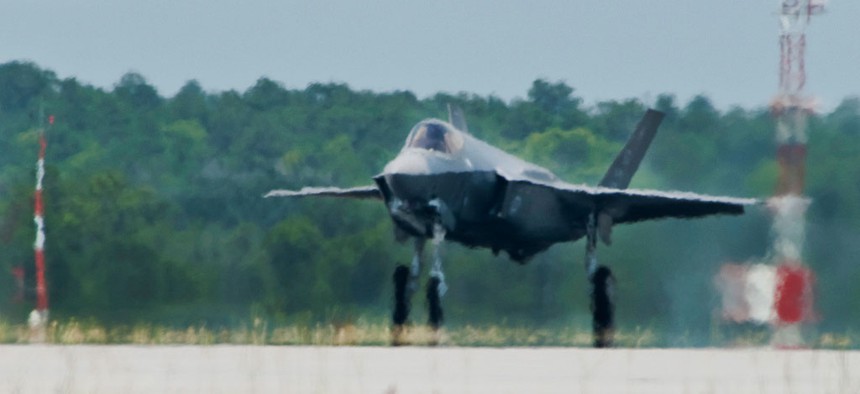
U.S. Air Force photo by Samuel King Jr.
5 Things You Need to Know About the Next Defense Budget
Here's what you need to know before the fiscal year 2015 budget is released on March 4. By Sara Sorcher
March 4 is the date to watch for Washington's defense wonks.
That's when the Pentagon plans to release its budget request for next year. And when the document drops, it will sound the starting gun for a slew of battles over military spending.
The budget deal Congress passed in December eased some of the Pentagon's pain from the sequester, which was intended to slice $500 billion from defense accounts over a decade.
But don't be fooled: The battles over next year's defense budget are far from settled. They will be perhaps the most contentious yet, and for the military, the stakes will be higher than ever. The Defense Department is running out of ways to cushion the blow from budget cuts, and this time, the ax will fall closer to the core.
Here's what to know before the starting gun sounds.
1. The budget deal hardly rectifies sequestration for the Defense Department in fiscal 2015.
Lawmakers are still basking in the sense of relief that flooded the Capitol after the budget deal passed. They shouldn't be.
Sen. Patty Murray and Rep. Paul Ryan's bill was meant to pay back some $63 billion in sequester cuts over two years. That's a sizable chunk of change. But the actual sequester relief going to defense for fiscal 2015 is $9 billion.
The Pentagon, which initially expected to request $541 billion, has to propose $43 billion in reductions, or else its budget would be subject to the across-the-board cuts. Unless, of course, the law is changed again.
Is there momentum in Congress to chip away further at sequestration?
"No. I really don't [think there is]," The top Republican on the Senate Armed Services Committee, James Inhofe of Oklahoma, said. "Not now. I wish I did."
2. A rumored $26 billion dollar wish list tees up a political minefield.
To meet the lower spending caps, the Pentagon is planning to submit a proposal for how it would spend an extra $26 billion on top of its budget request—if Congress can find the cash. Lawmakers will inevitably try to cherry-pick their priorities and try to find ways to fund them, or swap out programs in the main budget.
The concept is not totally out of left field. Starting in the 1990s, during the last defense downturn after the Cold War, the military sent Congress a list of initiatives it could not squeeze in the budget. The requests burgeoned during the last decade of war until then-Defense Secretary Robert Gates effectively put the kibosh on the practice around 2009.
This year, though, the wishlist will contain "actually validated and traditional requirements that can't be met simply because of the funding level," a Senate aide said. "This is not, 'If I had an extra dollar, this is what I'd do.' These are things already budgeted and planned for."
For instance, if the budget reduces the number of F-35 Joint Strike Fighter aircraft it plans to buy, or scales back the Littoral Combat Ship program, those leftover planes and ships may surface in the Pentagon's wish list.
Cue open season. Lawmakers are already staking out their positions. House Armed Services Seapower Subcommittee Chairman Randy Forbes, a Virginia Republican, is already insisting Congress won't support cutting any of the Navy's 11 aircraft carriers. The budget is likely to includereductions in pay raises for active-duty service members and fees for Tricare for Life, which will be controversial.
A wish list, though, could motivate Congress to fix sequestration. Senate Armed Services Committee Chairman Carl Levin sees the addendum as a list of "impacts" from budget cuts. "What will be in this budget, or left out of this budget, but described by the Pentagon in a way that would put pressure on us to get rid of sequestration for the '16 budget?" the Michigan Democrat said.
3. The Pentagon's financial cushions are pretty tapped out.
So far, the Pentagon has managed to avoid the full force of sequestration. It will feel the crunch this year.
Congress changed the law to give the department more flexibility. The Pentagon also tapped into its reserves of leftover funds from previous years to blunt the impact. This year, the department has a more meager backlog to draw from.
The Pentagon also deferred or delayed what David Berteau of the Center for Strategic and International Studies estimates is up to $20 billion worth of contracts for weapons programs and military equipment. As the defense budget continues to shrink, the Pentagon must abandon hopes for a future cash windfall and make crucial decisions.
"Eventually it catches up to you," Berteau said. "We are past the point of easy cuts."
These decisions may have a price—not just in terms of national security. Actual money. Breaking contracts meant to span for multiple years, such as the KC-46 tanker replacement or the Virginia-class submarine, could ultimately cost the U.S. government more—in penalties and fees—than it would save.
Program delays also may raise costs over the long term as manufacturers lose orders and lay off employees. The price per plane or electronic device is often based on a set quantity the government expects to buy. In the defense-contracting world, less volume can mean higher prices.
4. The wartime budget may turn into a slush fund.
The Pentagon's overseas contingency operations account, which has been tacked onto the budget for years to fund the wars in Iraq and Afghanistan, could serve as a budget gimmick.
It's supposed to be emergency war spending. But the OCO—which is not subject to the budget caps—may encompass other priorities that should, theoretically, be in the Pentagon's base budget.
This happened in fiscal 2014, when the cost per troop in Afghanistan skyrocketed to over $2 million from a remarkably stable $1.3 million in previous years, according to Todd Harrison at the Center for Strategic and Budgetary Assessments. The Pentagon apparently added at least $20 billion—and Congress another $10 billion—to the fiscal 2014 OCO account, for things not directly related to war, like depot maintenance for major weapons systems, and pay and benefits for service members not necessarily contingent on deployments.
The fiscal 2014 war funding request was $79 billion, for some 38,000 troops in Afghanistan. "If we see the troop level drop to about 10,000 in 2015, we should see a significant reduction in the budget—by almost a quarter," Harrison said. If the cost per deployed troop is higher—even as the size of the U.S. force is lower, and the scope of military operations smaller—that's a "good indicator we're adding costs in there that don't belong there."
5. The Pentagon could bust the budget caps next time.
The Pentagon is contemplating a $535 billion budget in 2016, some $36 billion over the sequester cap for that year. That's a sign the Pentagon may not be willing to make the really hard decisions this year.
If budget planners expected to meet the caps in future years, Harrison said, the Pentagon and lawmakers would need to agree to make significant reductions in force structure this year—potentially even cutting more brigade combat teams from the Army or a Navy aircraft carrier to prepare. That may not be in the cards. For instance, the Pentagon has already backed away from cutting the latter to avoid a political squabble with Congress.
So the biggest fights over programs may end up being #FY16Problems.




